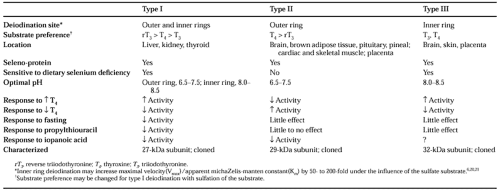PERIPHERAL METABOLISM OF THYROID HORMONES
T4 is metabolized by the sequential removal of iodine atoms. Although most human tissues have the ability to perform this enzymatic step, liver and kidney are the most important sites of deiodination.
The stepwise removal of iodine atoms from thyroxine has been well described.11 The process is enzymatic and depends on available sulfhydryl compounds. First, a hydrogen atom replaces iodine at one of four positions on T4. Subsequently, further iodine atoms are removed, yielding thyronines with two, one, and, finally, no iodine atoms. Iodine may be removed from the inner (tyrosyl) or outer (phenolic) ring. The entire process is referred to as sequential deiodination and is mediated by a family of enzymes listed in Table 30-3.
Removing either iodine atom from the outer ring (designated as the 3′ or 5′ position) of T4 yields T3. By convention, this pathway is referred to as 5′-deiodination. Two distinct enzymes are known to catalyze this process, monodeiodinase type I (5′D-I) and type II (5′D-II), both of which are described in Table 30-3. Because T3 has more metabolic activity than T4, this pathway represents activation. Intrapituitary conversion of T4 to T3 is important in the regulation of TSH secretion.
Removing either iodine atom from the inner ring (the 3 or 5 position) of T4 yields rT3. Reverse T3 has no known metabolic activity. It does not prevent goiter but is a competitive inhibitor of 5′D-I. Therefore, the 5-deiodination pathway catalyzed both by 5′D-I, at a different pH optima from that for phenolic ring deiodination, and by a type III seleno-enzyme (see Table 30-3) that is found in placenta, brain, and skin, constitutes an inactivation. Substrate conjugation with sulfate can increase the tyrosyl ring deiodination of T4 and T3 by 5′D-I several hundred-fold, thereby inactivating these hormones.17 T3 sulfate is produced in peripheral tissues and does not suppress TSH in normal humans. It may account for facilitated 5′D-I or augmented biliary losses in disease states.18 The sequential deiodination continues to yield thyronine and a family of diiodothyronines and monoiodothyronines that have uncertain bioactivity (see Fig. 30-1).
Stay updated, free articles. Join our Telegram channel

Full access? Get Clinical Tree







